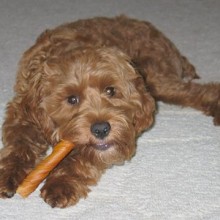Cavapoo
Lifestyle Needs

The name ‘Cavapoo’ is given to a cross between a Cavalier King Charles Spaniel and a Miniature Poodle (it is not a breed in the accepted sense). It is a small (but not a toy) dog and will have a variety of coat types and colour. The offspring of such parents is known as an F1 cross and may have the benefit of heterosis (or ‘hybrid vigor’) If two Cavapoos are mated together, this is known as an F2. An F2 bred to an F2 will result in F3, and so on. If an F1 is bred back to either parent breed it is an F1B. Temperament will vary, but typically, if well socialised as puppies, the Cavapoo will be a good natured pet. Frequent and regular grooming is essential.
Genetic Diversity
(Known as Coefficient of Inbreeding: 'COI'. It should be as low as possible.)
An F1 Cavapoo’s COI will be 0%
F1B (an F1 bred back to either breed) should be no higher than 6.25% (ensuring no common ancestry within great grandparents, or third generation)
F2, F3, F4 should be no higher than 6.25% (ensuring no common ancestry on 3 generation lineage record)
See 'A Beginners Guide to COI'
Gene Pool Size
(Known as Effective Population Size: 'EPS')
TBC
EPS is a measure of how many individuals are contributing genetically to a breed population. It is a measure of the size of the gene pool in a breed. Lower than 100 is considered critical by conservationists and below 50 brings a breed close to extinction. For more information see the Kennel Club article.
Health and Welfare Problems due to Conformation
(Body shape and physical characteristics)
- The Cavapoo’s coat can become tangled and matted if left ungroomed and could lead to skin problems.
BVA/KC Health Schemes: www.bva.co.uk/chs
- Chiari malformation Syringomyelia (CMSM) (CKCS: breed from older dogs with no SM and mild CM)
- Eye disease: Cataract (HC) (CKCS) (annual testing) (Multifocal retinal dysplasia (MRD) (CKCS) (litter screening); Progressive retinal atrophy (PRA) (Min Poodle) (annual testing)
- Hip dysplasia: breed mean score CKCS 15, Min Poodle 10 (parents should be lower)
Estimated Breeding Values (EBVs) : No EBVs are currently available for this breed
www.thekennelclub.org.uk/about-ebvs
DNA Tests Available
DogWellNet and IPFD Harmonisation of Genetic Testing for Dogs (HGTD)
www.dogwellnet.com/breeds
- See relevant parent breeds
Availability of a DNA test does not mean that it is always necessary or even desirable for breeders to use this test.
Other Breed-Specific Health Screening Schemes
- Kennel Club Heart Scheme (CKCS) recommended
Ask the breeder to show you the certificates for the above tests/screening for both parents. If any of the above tests have not been considered necessary by the breeder (and there may be good reasons), ask her to explain why.
Other Diseases Reported
(For which there are currently no genetic or screening tests for sire or dam)
- Check other diseases in both parent breeds.
Ask the breeder about the medical history of the parents, grandparents and great grandparents. Consider carefully whether to purchase a puppy if some of these or other diseases are in the family line.
Ask about the breeder’s policy in cases of serious genetic diseases occurring to your puppy in later life. Good breeders will request to be informed of such events in order to improve future breeding decisions.
You are strongly advised to buy from a breeder who uses (or is prepared to use) the AWF Puppy Contract and Puppy Information Pack (PIP): www.puppycontract.org.uk
The breeder should also be familiar with the CFSG/DBRG Code of Practice for Dog Breeding
Or the Kennel Club’s Assured Breeders Scheme Standard and Guidance:
Standard PDF | Guidance PDF